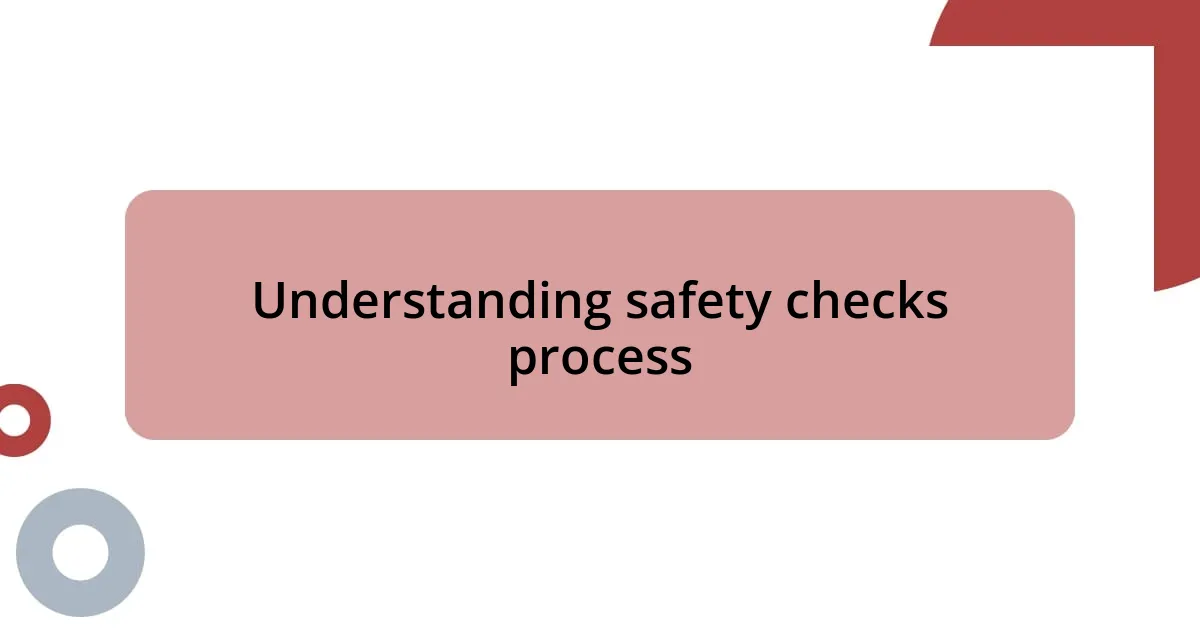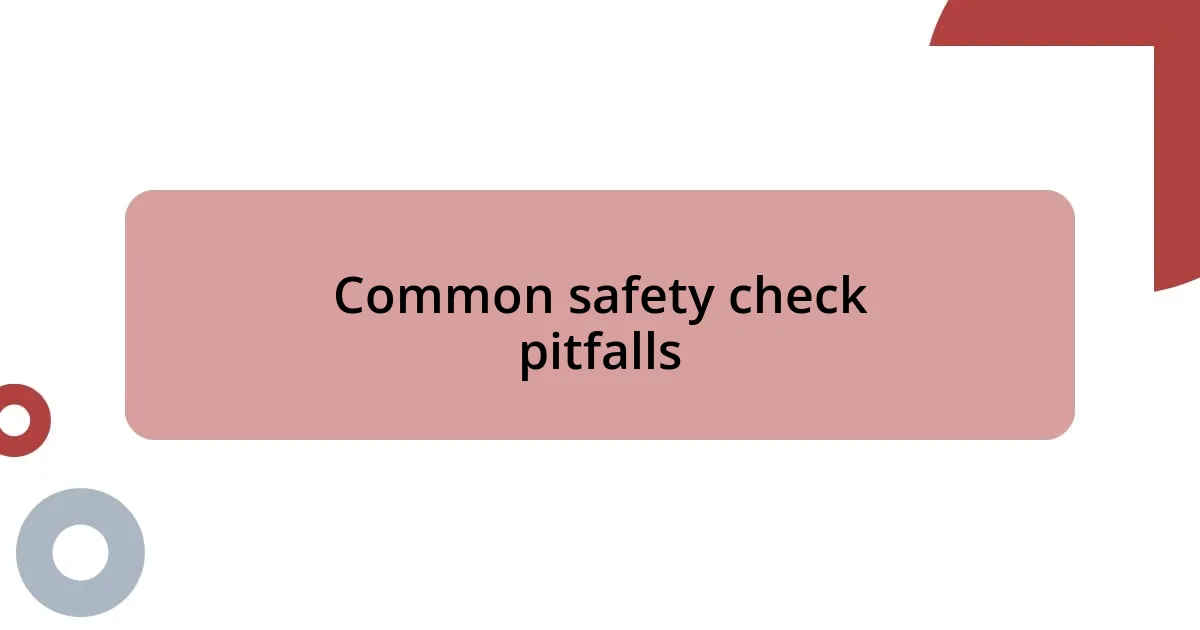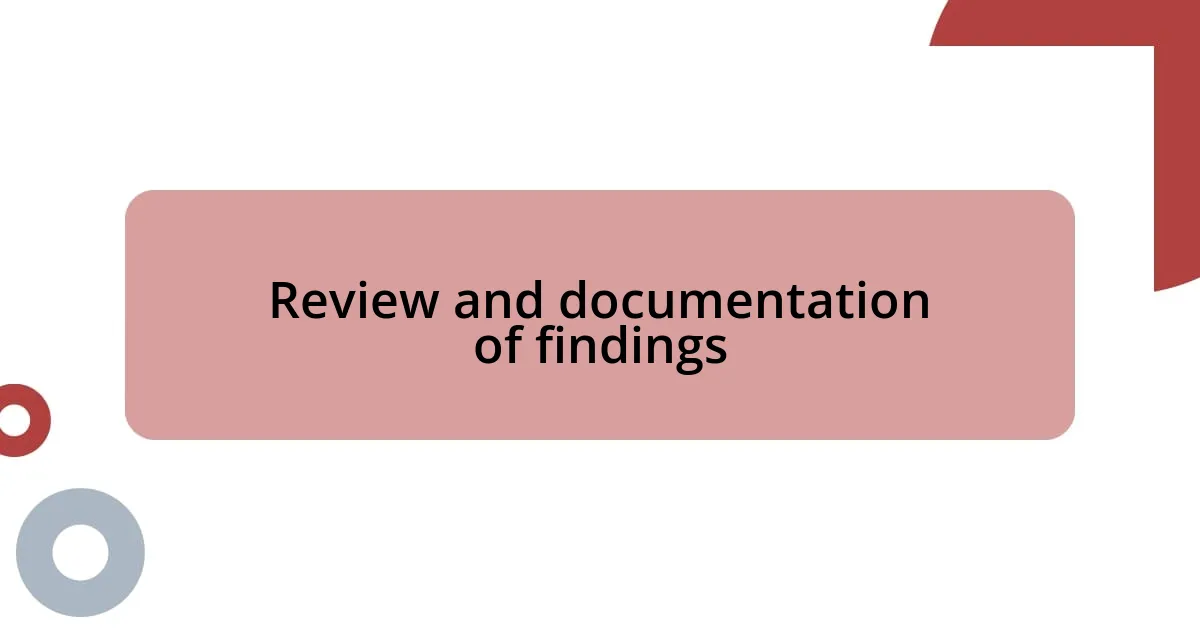Key takeaways:
- Attention to detail is crucial during safety inspections to prevent minor issues from escalating into serious problems.
- Regular safety checks are essential for accident prevention, legal compliance, and fostering a culture of accountability.
- Key components of safety checks include thorough equipment assessment, procedures analysis, and environmental inspections.
- Meticulous documentation of findings promotes a proactive safety culture and enhances team engagement in addressing safety issues.

Understanding safety checks process
When I think about the safety checks process, the first thing that comes to mind is the attention to detail required at every stage. It’s not just a box to check off; it’s about ensuring that everything is functioning correctly and safely. I remember the first time I conducted a thorough safety inspection; I was nervous but quickly realized how crucial each step was for everyone involved.
One of the most eye-opening moments for me was when I discovered a minor issue that could have escalated into something serious if left unchecked. Have you ever caught something just in time? It reinforced my belief that the safety checks process is about proactive problem-solving rather than reactive measures. Each inspection demands a systematic approach, where I meticulously review equipment, procedures, and even the environment to identify potential hazards.
I find that it helps to break down the process into manageable steps. For instance, I prioritize certain areas based on past experiences and known risks. Isn’t it fascinating how knowledge and instinct work together during these checks? Over time, I’ve learned to trust my instincts while also relying on data and guidelines, making the safety checks process both intuitive and informed.

Importance of conducting safety checks
Conducting safety checks is essential for creating a secure environment. I can’t emphasize enough how often I’ve seen minor oversights lead to major crises. For instance, during one inspection, I noticed a frayed cable in a high-traffic area. I instinctively knew it was a disaster waiting to happen. Fixing it immediately not only prevented potential injury but also reinforced my commitment to vigilance.
Here are a few reasons why conducting regular safety checks is crucial:
- Prevention of Accidents: Identifying potential hazards before they become issues saves lives.
- Legal Compliance: Many industries have strict regulations, and regular checks help ensure compliance, reducing liability.
- Peace of Mind: Knowing that protocols are followed fosters a sense of safety among employees and the public.
- Efficiency Optimization: Regular checks can enhance operational efficiency by addressing issues that might disrupt workflow.
In my experience, these checks cultivate an atmosphere of care and accountability that resonates throughout any organization.

Key components of safety checks
Safety checks are comprised of several critical components that ensure we’re not just completing a checklist but genuinely assessing the environment. For me, one key element is the equipment assessment; it’s where I often invest a considerable amount of time. I remember inspecting a ladder that, at first glance, seemed fine. However, upon closer inspection, I noticed it had a slight bend. It was a reminder of how crucial it is to look beyond the obvious.
Another vital component is the analysis of procedures. I once overlooked a safety protocol during a rush and saw firsthand the chaos that could ensue. It’s experiences like these that ingrained in me the importance of ensuring that every team member understands their role in maintaining safety. With clear, well-communicated processes, everyone knows what steps to take, which significantly reduces the potential for accidents.
Finally, I find that the environment itself can often hold hidden dangers. I learned this the hard way when a coworker slipped on spilled liquid in an area commonly walked through. Now, I always observe the surroundings—looking for signs of wear and tear, spills, or even overcrowding that could lead to hazards. Each of these components, when diligently checked, brings peace of mind not just for me but for everyone around.
| Key Component | Description |
|---|---|
| Equipment Assessment | Checking every piece of equipment closely to ensure it meets safety standards. |
| Procedures Analysis | Reviewing safety protocols to ensure all team members are informed and compliant. |
| Environmental Check | Inspecting the physical surroundings for hazards like spills or wear and tear. |

Step-by-step safety check guide
When conducting a safety check, I always start with a thorough inspection of the workspace. Just the other day, during one of my assessments, I noticed a light fixture flickering. I paused to think—what if the bulb was faulty, creating a fire risk? This kind of proactive thinking is crucial; it ensures I’m addressing potential dangers before they escalate into serious problems.
Next, I move on to the equipment review. There’s something about feeling the weight of a tool in your hand; it tells you a lot about its condition. I remember using an old power saw that had seen better days. The moment I felt its uneven vibrations, I knew it had to be replaced. It sparked a realization: when was the last time anyone else had checked it? Your experience with tools can make all the difference, and it’s why I advocate for frequent equipment evaluations.
Finally, I always finish with the emergency procedures session. This might not sound like the most exciting part, but don’t underestimate its importance! Revisiting evacuation routes with my team has revealed gaps in our knowledge that could be crucial during an emergency. During one session, a quieter employee pointed out that they didn’t fully understand the fire drill protocol. That moment struck me—what if we hadn’t clarified those details? Engaging the team in these discussions not only reinforces safety but also builds camaraderie and collective responsibility.

Common safety check pitfalls
One common pitfall I’ve encountered in safety checks is the tendency to rush through the process. I remember one day when we were pressed for time, and I thought I could simply gloss over the equipment assessment. Noticing a slight rust on a tool in the corner seemed mundane, but later that day it caused a minor injury. It made me realize how easily complacency can slip in during busy times. Have you ever found yourself cutting corners? It’s a risk that never pays off.
Another pitfall is assuming that everyone remembers the safety procedures. During one drill, I noticed several team members looking confused when asked about a specific evacuation route. It struck me how quickly important information can fade from memory. That’s when I decided that regular training wasn’t just a checkbox but a necessity. I always wonder, does everyone fully grasp what’s at stake? In safety, clarity is not just important; it’s lifesaving.
Then there’s the danger of overlooking environmental factors. Once, while conducting a routine inspection, I failed to notice some monitored chemical spills. Despite following the checklist, I became too focused on equipment and procedures. Later, a colleague pointed out the remnants while discussing the area’s overall safety. I felt a pang of guilt. How often do we become fixated on what’s familiar and miss crucial aspects? It’s a reminder that safety checks require a holistic view, always accounting for the unpredictable elements around us.

Review and documentation of findings
When it comes to reviewing and documenting findings, I’ve learned that meticulous notes can be a lifesaver. I remember a day at a facility where I found multiple safety hazards, including outdated first aid kits. After jotting down everything, I compiled an actionable report that highlighted each issue and its potential consequences. Have you ever thought about how easy it is to forget critical details? That’s why I emphasize the importance of thorough documentation—it creates a clear roadmap for future improvements.
Documenting findings isn’t just about writing down problems; it’s also an opportunity to reflect on our safety culture. I once had a moment of realization while reviewing past reports and noticed a recurring pattern: we failed to address minor issues consistently. This sparked a discussion with my team about how overlooked details can escalate over time. By categorizing recurring problems, we began fostering a culture of accountability. How do you think a team can shift from reactive to proactive safety?
Moreover, I find it helpful to organize findings in a way that everyone can understand. Simple charts or concise bullet points make a difference when sharing results with non-technical personnel. During a recent meeting, I presented our safety findings in a clear, visual format, and the reaction was enlightening. Team members who usually felt disengaged participated actively, asking questions and suggesting improvements. Isn’t it fascinating how clarity fosters collaboration? It reinforced my belief that good documentation paves the way for a safer, more informed environment.














